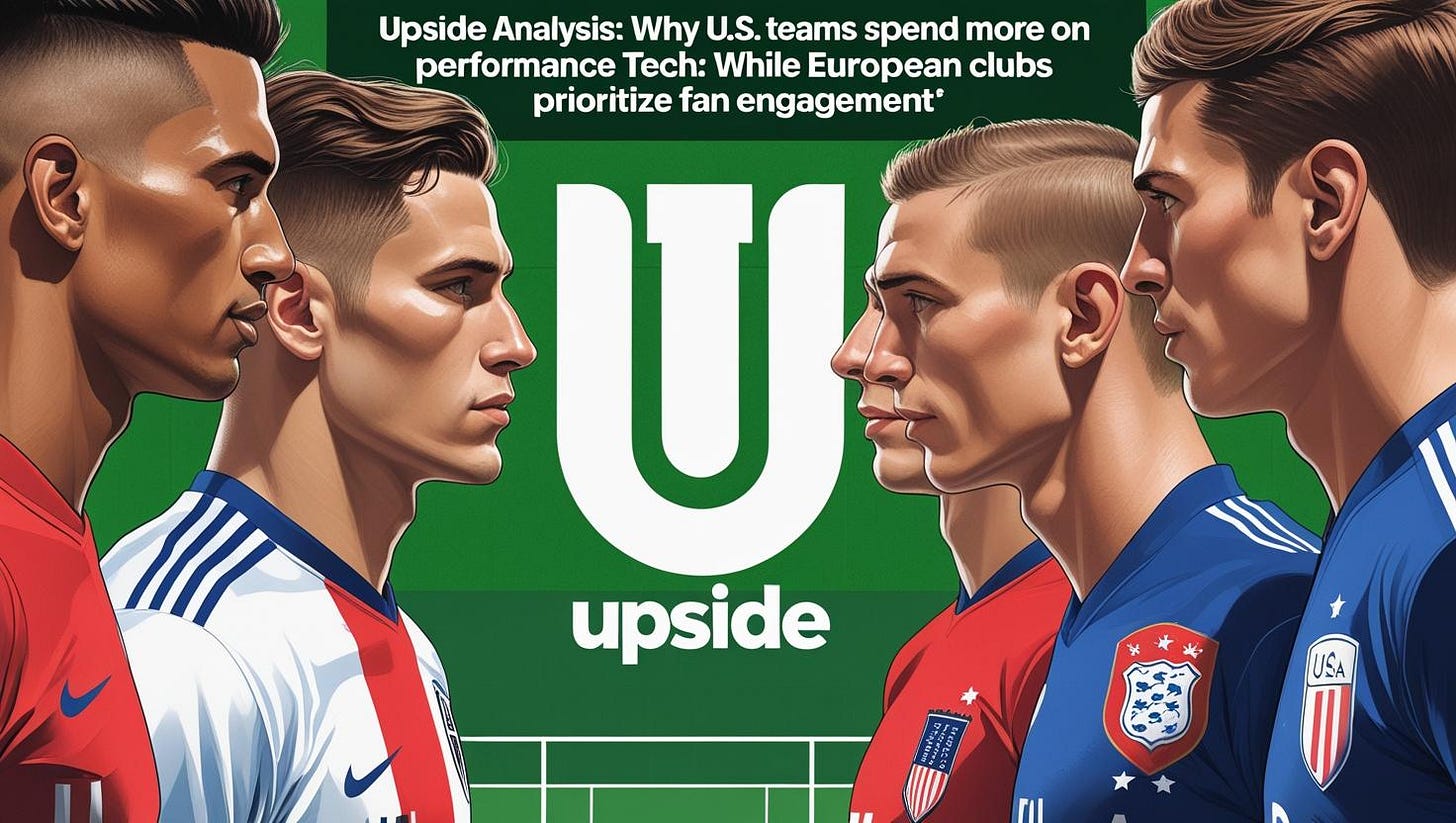📚 Upside Analysis: Why U.S. Teams Spend More on Performance Tech While European Soccer Clubs Prioritize Fan Engagement
Across the sports tech landscape, a fascinating divide is emerging between how U.S. and European teams allocate their budgets. In the United States, franchises across the NFL, NBA, MLB, and collegiate sports are pouring significant resources into performance technologies — tools and platforms that monitor, enhance, and protect athlete health and performance. Meanwhile, top European soccer clubs, especially those in the Premier League, La Liga, Bundesliga, and Serie A, are prioritizing fan engagement technology, sometimes allocating budgets in the millions, while spending less on performance systems — often under $300,000 annually.
This contrast reflects deeper cultural, commercial, and strategic differences in how teams approach success and sustainability.
1. The U.S. Sports Model: Performance Tech as a Strategic Asset
American franchises treat athlete performance and availability as core to their business model. The U.S. sports ecosystem is more closed-loop — with no relegation, player trades between franchises, and enormous financial penalties for underperformance (e.g., missing the playoffs in the NFL or NBA). In this context:
High investments are made in systems like Catapult, Kinvent, Whoop, Sparta Science, VALD, and AMS platforms like Teamworks, Smartabase, ActionApps or Orreco, just to name a few.
Based on the team survey data collected from the Upside tech scouting platform, annual performance tech budgets vary depending on the US leagues: Typically MLS teams have a performance tech budget in the $75k-$100k, while NBA/NFL teams have annual performance tech budgets in the $200k-$300k range.
Tech is tightly integrated into injury reduction, return to play, load monitoring, and even roster decisions.
2. Europe’s Fan-Centric Tech Playbook
In contrast, major soccer clubs in Europe are operating in a globalized and intensely competitive fan economy. While performance still matters, these clubs are brands — and in many cases, media companies with a ball. Their revenue models rely on:
Massive global fanbases across Asia, North America, and Africa.
Broadcast and streaming revenues tied to fan loyalty and engagement.
Commercial partnerships with brands hungry for digital reach.
As a result:
Fan engagement tech budgets often exceed $1–5 million annually, covering everything from mobile apps, AR/VR matchday experiences, digital collectibles (NFTs), personalized video content, and CRM integrations.
Performance tech is treated as a lower priority, with some top-flight clubs spending less than $300,000 annually on systems for monitoring or optimizing player performance.
Many clubs still operate with basic GPS systems and limited internal data science capacity.
3. Why the Gap Exists: Structural and Cultural Drivers
A. Financial Pressures
In U.S. sports, missing the playoffs means losing out on tens of millions in revenue, driving investment in injury reduction and peak performance.
In Europe, clubs emphasize global commercial viability. Performance helps, but fan loyalty is the real long-term asset.
B. League Structure
U.S. leagues are closed systems, giving teams freedom to invest long-term in tech and player development.
European leagues have promotion/relegation. Survival or international qualification may dictate short-term commercial decisions over long-term performance strategies.
C. Talent Development Pathways
U.S. athletes often progress through NCAA systems that already integrate tech.
European players frequently come from academies where the emphasis is on tactical coaching over biometric or recovery science.
4. What the Future Holds: Convergence or Divergence?
This divide may not last forever. There are signs of convergence:
U.S. teams are expanding into digital engagement — creating TikTok studios, AI content, and personalized fan loyalty systems.
European clubs are beginning to recognize the ROI of investing in performance — especially with aging superstars, fixture congestion, and expanded global tours.
As smart stadiums, AI, and hybrid monetization strategies evolve, the next generation of teams may need to master both domains.
6. Recommendations to Teams
For organizations aiming to strike the right balance between performance optimization and fan monetization, here are key recommendations:
A. European Clubs Should:
Increase Baseline Investment in Performance Tech: Even a modest lift to $500K annually can enable significant gains in injury prevention, recovery, and youth development.
Integrate Performance Data into Fan Content: Use real-time player data to enhance storytelling — blending the two strategies rather than choosing one.
Leverage Partnerships with U.S. Teams: Cross-league innovation sharing can help European clubs upskill quickly in performance science without starting from scratch.
B. U.S. Teams Should:
Treat Fan Engagement Tech as a Competitive Advantage: Gen Z and international fans expect digital-native experiences. Investing in fan platforms can deepen brand loyalty, especially in global sports like the NBA.
Monetize Performance Tech Insights: Develop public-facing content based on behind-the-scenes data — e.g., athlete recovery stories, training loads, or weekly performance dashboards.
Build Scalable Content Engines: Use AI to personalize video, highlights, and stories for millions of users — especially in sports where viewership is declining or fragmented.
C. For All Teams:
Adopt a Dual-Tech Strategy: Leading teams of the future will not separate performance from fan engagement — they’ll find ways to amplify one with the other.
Invest in Data Teams: Whether it's sports scientists or fan data engineers, every top team will need analysts who can extract value from information in real time.
Plan for Convergence: AR, wearables, biometrics, and gamified fan platforms are converging. The most prepared clubs are already budgeting for this future.
Conclusion
The gap between U.S. and European tech priorities in sports is rooted in structural realities — but it’s not set in stone. The next phase of sports business will reward those who can integrate athlete data and fan engagement into a unified engine of growth. Whether you're building the most durable roster or the most loyal fanbase, technology is now central to how success is built and sustained.
Best,
You may also like:
🏟️ Upside European Trip Recap: 11 Key Trends and Takeaways from Our Conversations with Elite Clubs and National Teams
Over the past few weeks, we had the opportunity to meet with high-performance leaders, technology & innovation heads at top-tier clubs, national teams and elite performance environments across Europe. The experience offered a compelling view into how these teams and national teams are thinking about innovation, adopting new technologies, and shaping the…



